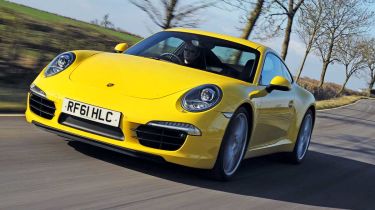Porsche 911 Carrera S
Has iconic car been improved by its most radical redesign yet?
Believe it or not, 90 per cent of the new 911’s parts have been either redesigned or redeveloped. That isn’t immediately obvious from the outside, as it has the recognisable outline of its predecessors and ticks all the 911 styling boxes. But there’s been major surgery.
The new car has a 100mm longer wheelbase to improve ride comfort and cabin space, as well as a wider track to aid stability and reduce roll. Widespread use of aluminium means it’s lighter than the old model, and the end result makes the Jaguar look big and heavy by comparison.
The driving position is spot-on and the forward view is pure 911, with raised front wings either side of a low nose. The cabin is inspired by the Panamera, and while the chiseled centre console looks heavy handed and full of buttons, it works well. The high- quality switchgear is arranged logically and the focus is firmly on the driving experience, as there are no steering-wheel buttons.
Instead, separate stalks operate the cruise control (a £267 option) and multifunction display on the dash. Leather trim is standard, but you’ll need to spend a small fortune on extras to match the spec of the cheaper XKR. Surely parking sensors, cruise control and Bluetooth should be standard for £84,000?
Used - available now

2022 Volkswagen
T-Roc
17,011 milesManualPetrol1.5L
Cash £18,049
2025 Cupra
Ateca
25,552 milesAutomaticPetrol2.0L
Cash £28,199
2021 Audi
A6 Avant
51,430 milesAutomaticDiesel2.0L
Cash £23,699
2022 BMW
3 Series
56,916 milesAutomaticDiesel2.0L
Cash £23,499But the 911 starts to look like better value once you get behind the wheel, because this car is all about the driving experience, and it doesn’t disappoint. The longer wheelbase and sleek aerodynamics have done their job, as the Porsche rides better than before and there’s less wind noise at cruising speeds. Yet it hasn’t gone soft – it’s still a proper sports car.
While the Jaguar encourages you to take things easy, smoothing out bumps more effectively and delivering serious torque almost from idle, the more engaging 911 spurs you on. Power from the 3.8-litre engine has risen from 380bhp to 395bhp, and its unique flat-six howl provides an intoxicating soundtrack. Our car was fitted with the £1,772 optional sports exhaust, but standard models will also sound the part as the engine shrieks towards its 7,500rpm red line.
It beats the Jaguar for noise, but the 911 takes second place for power, and the 503bhp XKR easily pulls away from the Porsche in a straight line. The 911 trailed in all our in-gear tests, losing to the Jag from 50-70mph in sixth by four tenths, with a time of 6.6 seconds.
This only tells part of the story, though, because the Porsche has stronger brakes, and its superior traction off the line had our testers blinking in disbelief.
A combination of its rear-engined traction, our test car’s slick PDK automated manual gearbox and optional launch control saw the 911 cover 0-60mph in a scorching 3.7 seconds – that’s seven tenths quicker than the Jaguar and four tenths better than Porsche’s claimed figure.
Suffice to say, the 911 is monumentally fast from a standing start. Plus, its superior handling means it can show the XKR a clean pair of heels in corners. The new electro-mechanical steering is one of the most controversial changes, and while it does rob the Porsche of some feedback, you need to drive the old and new models back-to-back to notice the difference. It’s still perfectly weighted, incredibly precise and responsive, and inspires more confidence than the Jag.
In corners the car’s tenacious grip and crisp responses are a revelation, and selecting Sport mode stiffens the suspension for even sharper reactions. Porsche’s £2,185 Dynamic
Chassis Control virtually eliminates body roll, boosting agility and putting this car in a different league to the softer XKR.
Any complaints? Well, cubby stowage is limited, the tyres generate lots of noise on some surfaces, the fuel tank is pretty small and the shift paddles for the PDK gearbox aren’t especially positive. But none of this detracts from what is the best 911 yet.
Details
Chart position: 1
WHY: Porsche’s iconic coupe has been motoring royalty for decades, but is the king dead? Does the latest 911 still embody the spirit of the original?







